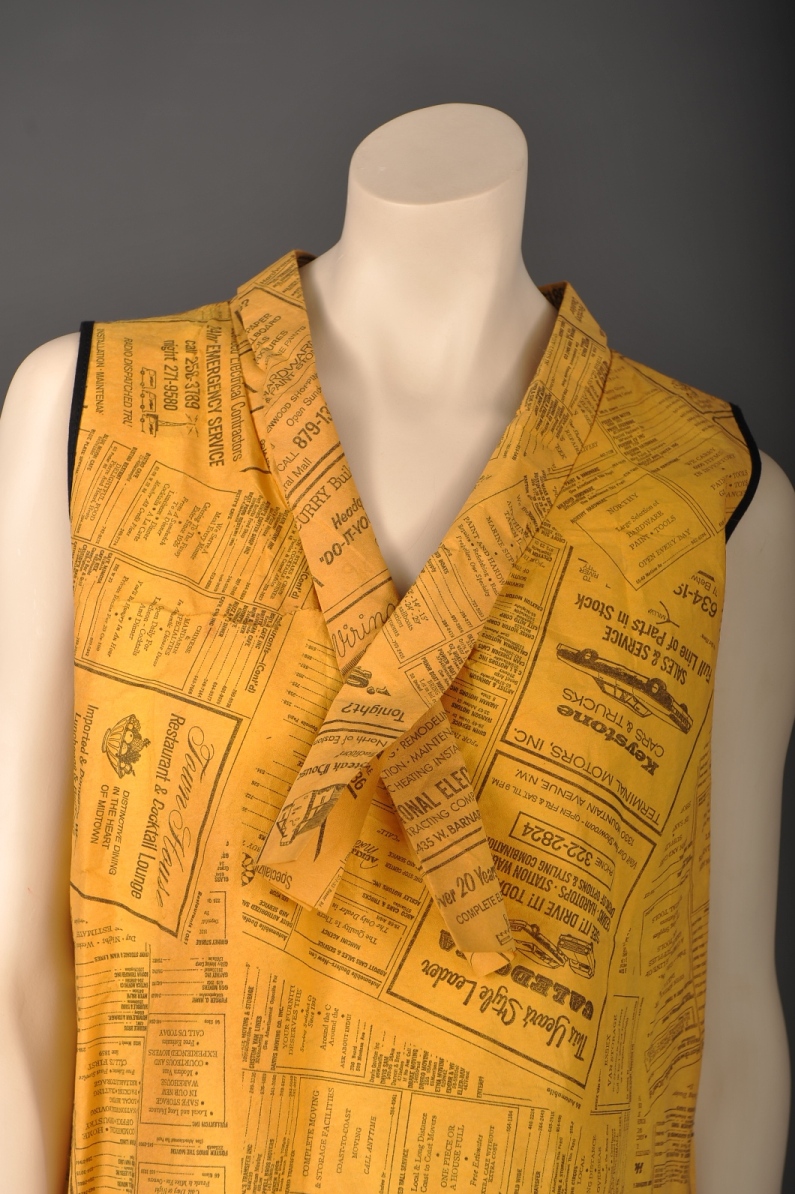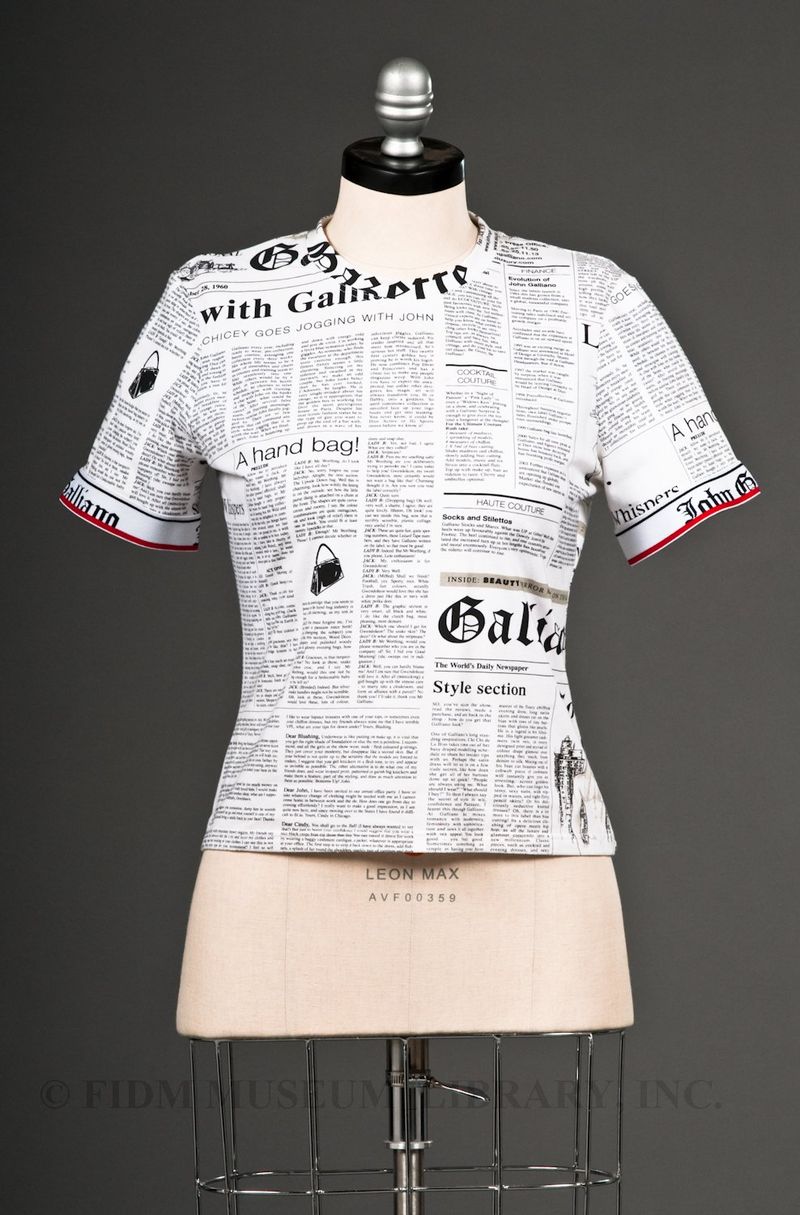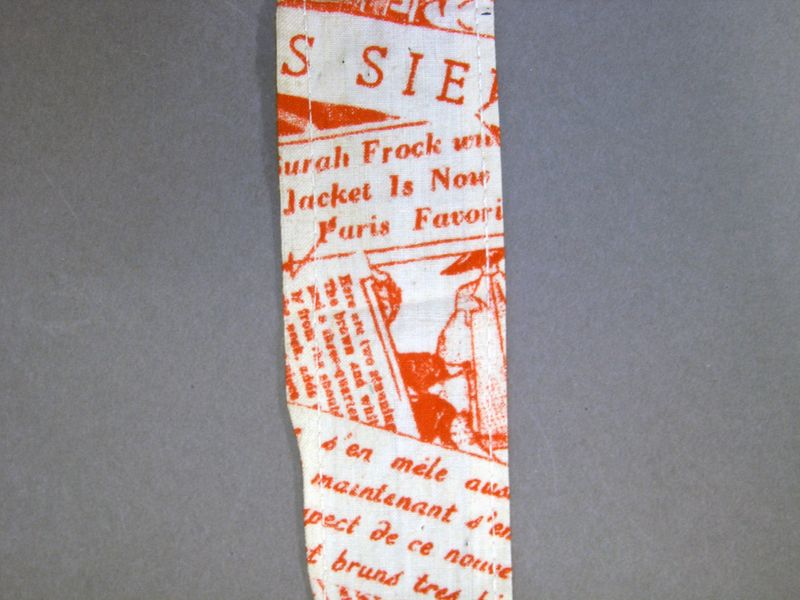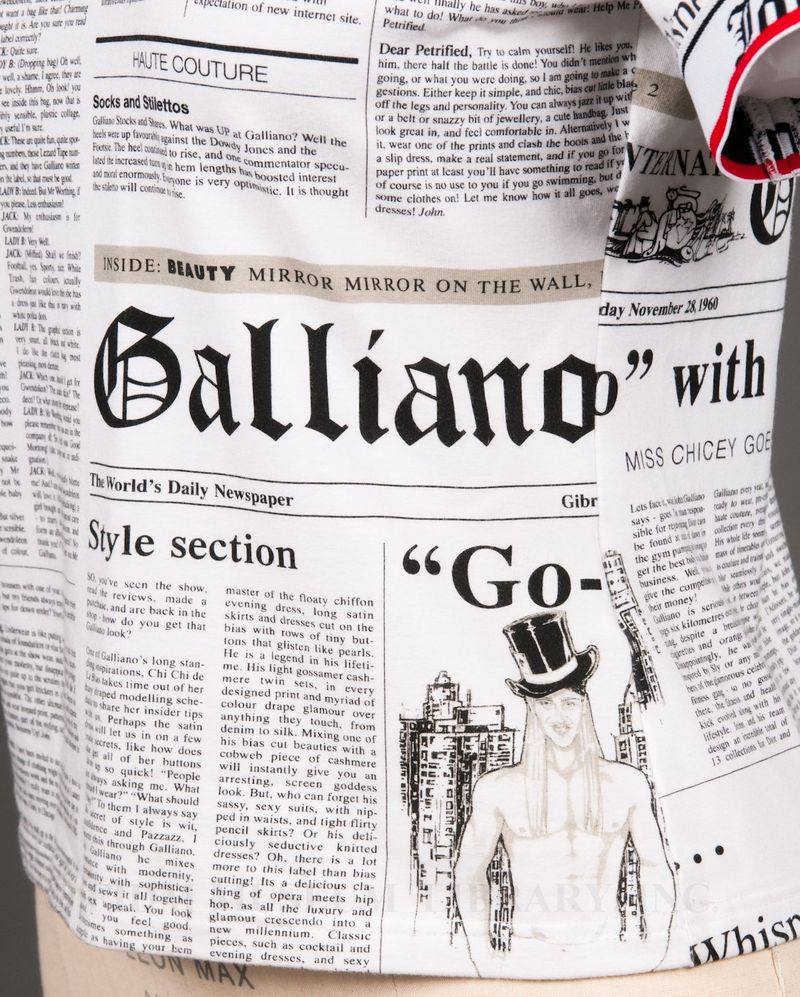A Paul Poiret c. 1911 tunic and the daily newspaper–what do they have in common? At first, the relationship between a haute couture creation and the local newspaper might seem almost non-existent, however, both are communicative devices that convey information to an observant reader. The text of the newspaper (either online or printed) is read to obtain the latest political news, sports scores, weather and cultural commentary. An outfit, whether haute couture or ready-to-wear, can be read for specific information about the wearer along with more general information regarding the place and time in which it is worn.
Clothing constructed from actual paper, sometimes even newsprint, is most often associated with the late 1960s paper dress trend and late 19th/early 20th century fancy dress costumes. This 1966-69 Wastebasket Boutique paper dress is printed with a collage of advertisements and phone book listings. To learn more about the history and context of late 60s paper dresses, read our Would you believe it's paper? blog post.
 Paper dress
Paper dress
Wastebasket Boutique
1966-1969
Gift of Mr. & Mrs. Alfred Himelson
97.350.1
Newsprint inspired John Galliano's S/S 2000 collection for Christian Dior and ignited a controversy about 'hobo chic.' In January 2000, Galliano presented a "down-and-out collection of oversize tramp pants and urchin skirts artfully printed with the fashion pages of The International Herald Tribune."1 Though a haute couture collection, the overall aesthetic apparently owed more to deconstruction than the elegant traditions of the haute couture. One dress from this collection, featured in the April 2000 issue of Vogue, consisted of a ragged, sleeveless gray chiffon overdress with an uneven hem layered over an underdress of newspaper print silk. The look was accessorized with a fork pin on the bodice and combat boots. According to the designer, the collection was inspired by homeless people sleeping along the edges of the Seine, Parisian "tramp balls" of the twenties and thirties, where wealthy socialites dressed as paupers, and Diane Arbus photos of the mentally ill. Of the homeless individuals along the Seine, Galliano said, "''Some of these people are like impresarios, their coats worn over their shoulders and their hats worn at a certain angle. It's fantastic.''2
Of course, it wasn't the newspaper print itself that inspired the controversy, but the aestheticization of poverty represented by Galliano's reappropriation of a humble material. Knowledge of Galliano's collection spread beyond the fashion world, causing commentator Maureen Dowd to condemn Galliano's "tasteless" collection.3 Shades of this controversy reemerged in August 2009, when noted style-blogger The Sartorialist valorized a picture of an apparently homeless man on his blog. Galliano is known for appropriating cultures and historical moments with abandon, so his incorporation of 'hobo chic' isn't surprising. The newspaper printed textiles themselves have been incorporated into Galliano's repertoire, reappearing in both Christian Dior collections and in his eponymous line. Galliano's Fall 2004 ready-to-wear collection featured a variety of newspaper printed dresses. This T-shirt highlights a more casual incarnation of Galliano's newspaper print.
 John Galliano
John Galliano
2002-2004
Museum Purchase
2005.5.11
Galliano usually incorporates images of himself, along with text related to his work, into his newspaper printed textiles. The textile thus becomes a complicated logo and promotional tool, unmistakably linked to Galliano. Unlike a haute couture creation, which often takes a discerning eye to read its significance, Galliano's newsprint textile is easily read by all.
Like John Galliano, Elsa Schiaparelli designed a newspaper print textile based on press clippings related to her work. In her autobiography, Shocking Life, Schiaparelli wrote that she used the resulting textile to make "blouses, scarves, hats, and all kinds of bathing nonsense."4 The textile was also sold as yardage. Like Galliano, Schiaparelli was inspired by the dress of a different economic class, fishwives seen on a 1935 vacation to Copenhagen market. In her autobiography, she wrote: "These women wore on their heads newspapers twisted into queer shapes of hats. Schiap stood and looked for awhile."5 (Shocking Life switches between first and third person–confusing for the reader, but right in line with Schiaparelli's interest in Surrealism.) After this experience, Schiaparelli returned to Paris and commissioned her newsprint textile. Unlike Galliano's newsprint textile, Schiaparelli's textile and its origin caused no controversy. Separated by 65 years, these differing reactions to similar phenomenons highlight dramatic shifts in social mores during the intervening years.
This piece of the Schiaparelli newsprint textile was used purchased as yardage and used for an unknown purpose.
 Elsa Schiaparelli
Elsa Schiaparelli
1935
Gift of Robert Fortunoff
99.274.221A-C
1 Horyn, Cathy. Gaultier's Triumph: Crystal Jeans Add Realism to Couture. New York Times 18 Jan. 2000: B8.
2 Dowd, Maureen. Liberties; Haute Homelessness. New York Times 23 Jan. 2000: A10.
3 Ibid.
4 Schiaparelli, Elsa. Shocking Life. London: J.M. Dent & Sons, Ltd. 1954: 74.
5 Ibid.



Galliano! I love your newspaper print dresses and other Nwspaper prints. I wish to order a couple of items when those items return in stock. Your fashions are all beautiful. I love the Christian Dior dress by you and I would like to have it. your work is excellent! Love the clothing.
Do you sell newsprint fabrics?
We do not sell any fabrics–we only collect!